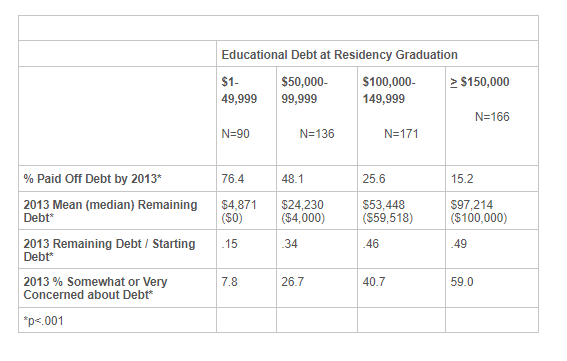William L. Cull, PhD1, Elizabeth Schott, MA1, Shesha K. Katakam, MD, MPH2, Mary Pat Frintner, MSPH1 and Amy J. Starmer, MD, MPH3. 1AAP, Elk Grove Village, IL, United States; 2Indiana University Health La Porte, Valparaiso, IN, United States and 3Boston Children's Hospital, Boston, MA, United States.
Background: Pediatrician educational debt has been steadily increasing. Less is known about pediatricians' pace of repayment.
Objective: Examine patterns of debt repayment for pediatricians graduating residency in 2002-2004.
Design/Methods: National, weighted 2013 data from the AAP Pediatrician Life and Career Experience Study (PLACES) were utilized (n=840). Pediatricians were categorized based on their own educational debt level upon completion of residency training ($1-49,999, $50,000-99,999, $100,000-149,999, > $150,000). Progress in debt repayment was explored using multiple measures: 1) % of pediatricians who have paid off debt completely, 2) mean remaining debt, 3) ratio: remaining debt/original debt, and 4) % reporting somewhat or very concerned about their educational debt. Multivariable logistic regression examined possible predictors of concern about educational debt (measure 4) while controlling for starting debt level (predictors: gender, marital status, children, race, IMG, subspecialty care, salary > $200,000, part-time).
Results: 31% of 2002-2004 graduates had no debt when they completed residency training; mean debt at graduation among those with debt was $115,365, with a maximum of $810,000. A decade following graduation, complete debt repayment varied from 76% of pediatricians who started with < $50,000 debt to 15% of pediatricians who started with $150,000 in debt or more [table]. The proportion of pediatricians concerned about their debt increased with level of debt, with over half of pediatricians with the highest debt still concerned. Starting debt was strongly linked with all examined measures, p<.001. When starting debt was controlled for in the multivariable model, female gender (AOR=1.90, 95%CI=1.20-3.02) was associated with greater concern about debt.

Conclusions: Within a decade following graduation, substantial progress toward debt repayment was apparent. Yet many are still concerned, especially those with higher starting debt. This has implications for more recent residency graduates where a higher percentage start in the higher debt categories.